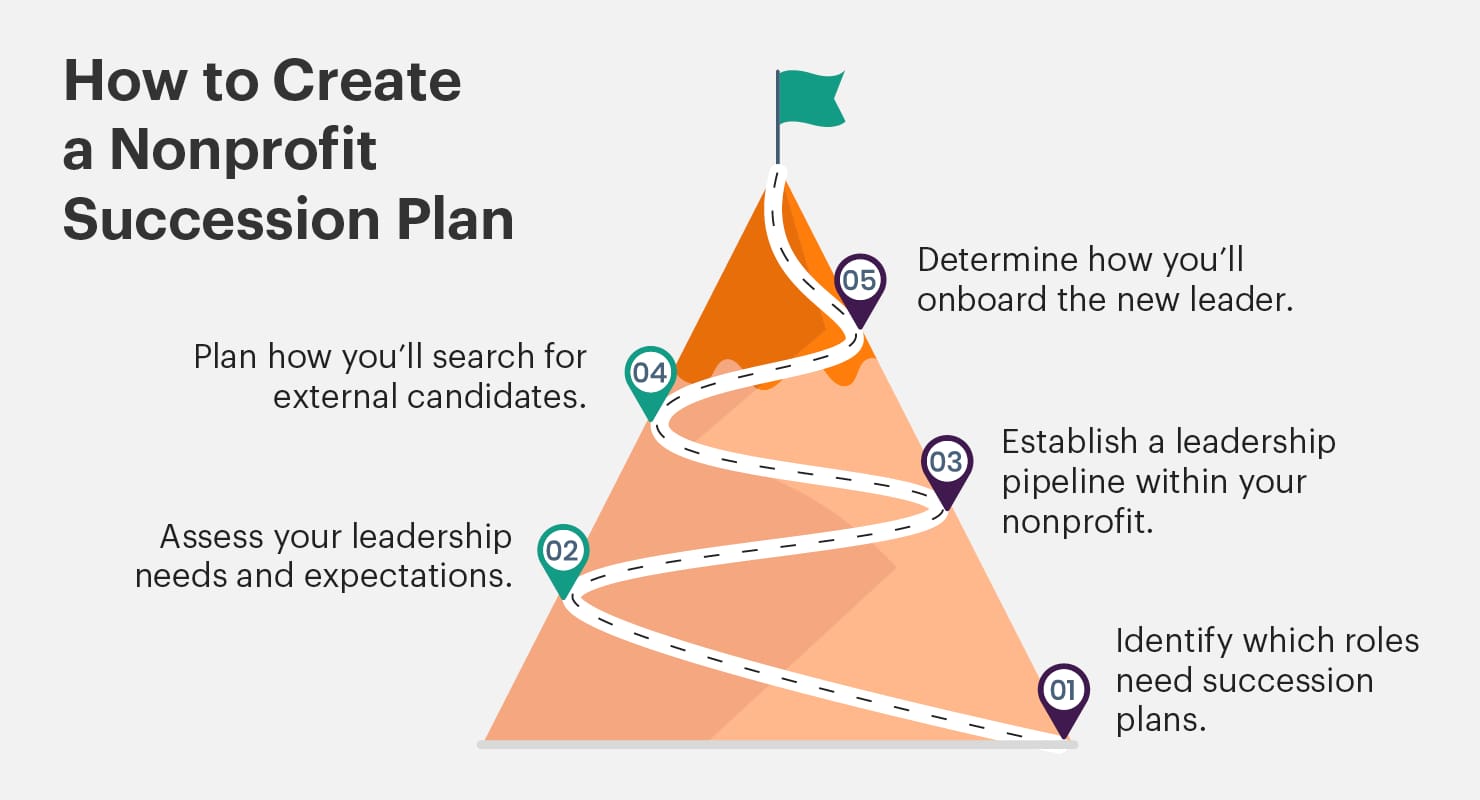Your leadership and board members carry out essential responsibilities to keep your nonprofit progressing steadily toward your goals. They review your budgets; help you ensure legal compliance and provide guidance to steer the organization toward long-term success.
But when one of these key individuals leaves your organization, how do you maintain momentum and concentration on your mission? This concern is why the process of nonprofit succession planning is so important.
By creating well-documented succession plans, you can ensure that your nonprofit can navigate leadership transitions with minimal delay or disruption.
In this article, we’ll cover the basics of succession planning, including five steps to create a succession plan for your nonprofit. With enough preparation in place, you can stay focused on making an impact in your community through both steady and changing times.
Why is Succession Planning Important for Nonprofits?
Developing a succession plan might not seem necessary or urgent when all roles are full, and everything is running smoothly. However, an executive or board member may choose to end their term early at any time, and you want to be prepared if that happens.
Through nonprofit succession planning, you can:
- Find the best candidate to fill the soon-to-be vacant role.
- Assemble a diverse leadership team and board.
- Select a new leader who’s aligned with your mission, vision and values.
- Ensure the new leader is a good cultural fit.
- Equip the incoming leader with everything they need to succeed in their role.
Having detailed succession plans at the ready ensures that you waste no time in locating qualified, suitable candidates to take on empty leadership roles at your nonprofit—no matter when they become available.
How to Create a Nonprofit Succession Plan
Succession planning outlines the activities you can take before, during and after leadership transitions to help your organization keep up its current pace and initiatives. To create succession plans for your nonprofit, assemble your leadership team and walk through the following steps together:

1. Identify which roles need succession plans.
There’s no one-size-fits-all succession plan that you can apply to any role within your nonprofit. After all, each role has its own expectations, tasks and responsibilities. Start by identifying which individuals in your organization have the most direct influence on your overall operations and success.
Some common roles to develop succession plans for include:
- Executive director
- Program directors
- Major gift officers
- Board members
Build contingency plans around these individuals, for both planned and unplanned departures. Establish an emergency succession plan by pinpointing potential candidates who can swiftly step up to the position if needed.
2. Assess your leadership needs and expectations.
Your leadership and board members must work as a team to map out your nonprofit’s future, stay true to your mission and accomplish the impact you set out to make. To ensure that new leaders embody your values and carry the torch left by your previous leaders, take the time to:
- Define your nonprofit’s culture, so everyone at your organization understands what you’re looking for in a candidate.
- List the challenges your executives and board members face to figure out the skills and qualities candidates will need to overcome them.
- Ask the current leader to draft their own job description based on their experience of the work involved.
If you run into any differing opinions or confusion regarding your leadership expectations and requirements, refer back to your latest strategic plan. According to Laridae, a strategic plan is an excellent resource for managing changes within your nonprofit, “anchoring your organization when it encounters rough waters and propelling your impact forward when the way is clear.”
As long as you maintain a strong, distinct vision for your nonprofit, you can follow through on your overarching objectives from one leader to the next.
3. Establish a leadership pipeline within your nonprofit.
It’s more than likely that your nonprofit already has passionate and capable leadership candidates among its staff or volunteers. This means that, if you ever face a leadership transition, one of the best places to begin looking for a replacement is within your organization.
These individuals are already familiar with your programs and priorities—all you need to do is prepare them to take on more responsibilities and decision-making. Start by training your managers, program coordinators and volunteer leaders to help them develop confidence, communication skills and strategic thinking abilities.
For instance, you can enroll them in online cohort-based courses or recommend podcasts that they can listen to in their spare time.
Additionally, you can build capacity and prepare potential candidates by setting up a mentorship program involving your executive director, board, staff, and volunteers. This way, current and aspiring leaders at your nonprofit can openly collaborate and share expertise to secure your organization’s future.
4. Plan how you’ll search for external candidates.
While searching internally is often the first step, your nonprofit should still remain open to recruiting external talent to fill your leadership and board positions. These individuals may be able to close gaps in skills or experience and bring new perspectives to your organization.
Several ways you can find promising external candidates include:
- Posting a job description on LinkedIn, Indeed, and other job boards.
- Asking your board and staff to share on social media that you’re searching for a candidate.
- Having your leadership and board members interview candidates as a group to see how they function in a team environment.
Focus on soft skills and personality rather than hard skills, such as financial management or fundraising expertise. While new leaders can always learn hard skills, their soft skills will allow them to fit in and succeed in your organization in the long run.
5. Determine how you’ll onboard and monitor the new leader.
Once you’ve decided on the best candidate for the role, consider how you can help them adjust to their new tasks and responsibilities. Double the Donation suggests kicking off orientation by sending an internal announcement and hosting a welcome event to provide a supportive environment for the new leader from day one.
Additional steps you can take include:
- Bringing the new leader in for a training day with the current leader prior to the transition.
- Archiving the current leader’s email account and making it available to the next leader.
- Provide necessary access and permissions to any software you use to run your nonprofit.
- Encouraging the leader to re-establish relationships with the past leader’s connections by calling or emailing to personally introduce themselves.
- Keeping the former leader on call as an advisor.
- Designating an “emergency” contact that the new leader can contact at any time with questions.
It can take time to transition fully into a new position, culture, and staff team, so give your new leader some room to get accustomed to their role.
Consider temporarily assigning some tasks to other board members or volunteers so the new leader can focus on solidifying your nonprofit’s vision and direction instead of the initial administrative work.
3 Tips for Nonprofit Succession Planning
There’s a lot that goes into nonprofit succession planning, but it doesn’t have to be an overwhelming undertaking for your team. Keep these tips in mind to pave the way for more seamless leadership transitions:
- Put together a comprehensive handbook. Document all of the basic information about your nonprofit, including its mission, history, workplace policies and programs. Store key resources in a shared location, such as Google Drive, so anyone at your organization can access them when needed.
- Recruit a volunteer to help out. Consider creating a volunteer role specifically to support your succession planning. They can put together templates, reach out to your stakeholders for feedback and more.
- Conduct exit interviews. Learn more about why a leader or board member is leaving to identify patterns and areas for improvement. At the same time, take the opportunity to discuss their leadership approach, communication practices and decision-making processes to inform your candidate search.
If you’re not sure how to create succession plans that align with your nonprofit’s mission and objectives, reach out to experienced nonprofit consultants who can guide you through the process. They can even help you put together a strategic plan and ensure that your succession planning contributes to your overall goals and success.
Even when your nonprofit isn’t undergoing or expecting significant changes, review and update your succession plans at least once a year. Keep your current executives and board members invested by engaging them in the process and expressing your appreciation for their hard work. With proper preparation, you’ll be able to unite a community of former, current and aspiring leaders to power your nonprofit’s work.









